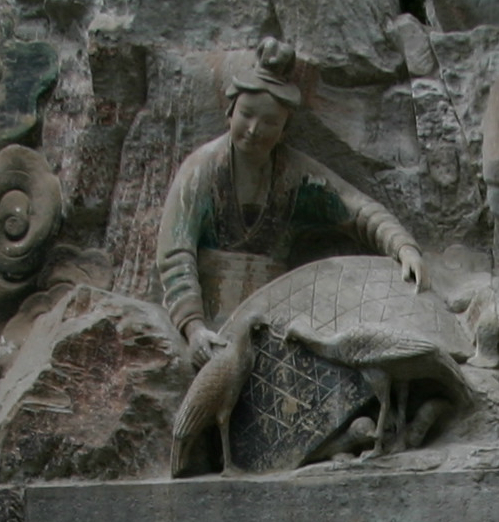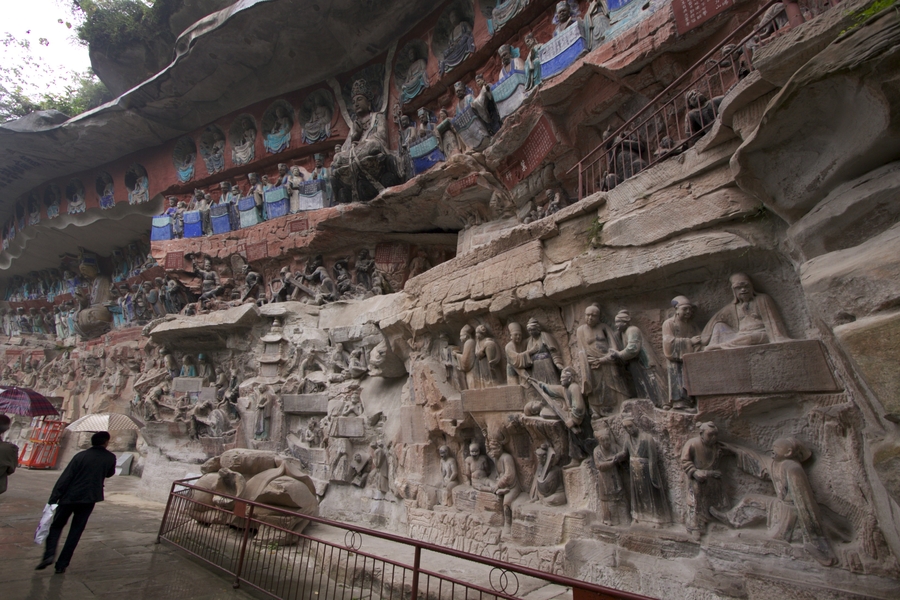The image of the “chicken-feeding girl” is carved from the living rock on a half-mile long hard sandstone rock outcropping at Baodingshan within the historic province of Sichuan, China. Originally realistically painted, this high-relief sculpted work is often misunderstood, if not exactly misidentified. Crouched over her wicker basket pen, the Chicken-Feeding Girl attentively watches as two chickens strut outside of the basket while small chicks poke their heads out from underneath its protective cover. To most modern visitors, the Chicken-Feeding Girl displays the stereotypical concern of a doting mother, and a number of scholars have described this image as representative of the pastoral life of the region during the Song Dynasty (960—1279 CE). While this is in fact one way to interpret the work, the Song dynasty audience for Chicken-Feeding Girl read her presence at the site in an entirely different manner.
Placed within the depths of the Eighteen Hells at Great Buddha Bend, Baodingshan, Chicken-Feeding Girl looks out at the present day viewer the same as she did for the twelfth-century worshipper. Outwardly she may be construed as innocent, yet the segment of Buddhist text inscribed next to her leaves no room for doubt as to why she is there; in traditional Chinese script it states, “All those who raise animals shall suffer the torments of hell...”
When most people visualize Buddhism, they tend to think of lotus blossoms and yogic poses, a peaceful Buddha in meditation. Rarely does one envision pain and torture, hell-fire amidst boiling pots of oil, people impaled upon sharp swords. Yet in medieval East Asia, hell figured prominently in Buddhist teachings, the pains presented therein juxtaposed with the rewards of the paradise of the Western Pure Land. The Pure Land appears within the Mahayana tradition in India and spreads to China in the second century CE, eventually moving to Korea, Vietnam, and Japan. The central premise of the teaching is to move from this worldly existence into that of the Western Pure Land over which Amitabha Buddha presides; by doing so, one is freed of the possibility of reincarnation in this earthly realm, and thereby well on one’s way to eventual nirvana.
Various methods were promoted to get to the Pure Land. One simple approach was repeatedly chanting Amitabha Buddha’s name. Other means involved making offerings to the Buddhist clergy or having Buddhist texts and images created. Failure to do so meant a return to the wheel of reincarnation and all the possible rebirths therein figured: animal, human, hell dweller, hungry ghost, deva, or titan. The Chicken-Feeding Girl depicted at Baodingshan is headed towards the realm of hell dweller. Within the tableau, she is placed next to a hungry ghost and a human in the form of a monk. While the monk is gaining good merit towards entering the Pure Land for his deeds of preaching the evils that leads one to hell, the Chicken-Feeding Girl is gaining bad karma for raising animals that will eventually be slaughtered and eaten.
Images related to both hell and the Pure Land are found side-by-side at Baodingshan and figured prominently in cyclical rituals on behalf of the deceased. The most common timetable was the “7 7s”, a series of rituals that took place at weekly intervals for seven weeks after an individual’s death plus 100 days and 3 years for a total of 10 rituals including the initial funerary rites. These were performed in combination with offerings to various entities, the most notable being the Ten Kings of Hell, whose images can be seen above that of the Chicken-Feeding Girl at Great Buddha Bend. It was believed that the deceased would pass in front of each of the Ten Kings on those days and, without proper “payment” in hand for the King, i.e., good karmic deeds, would spend time in the hells underneath a king’s jurisdiction.
Within this medieval mindset, the punishment fit the crime. The Chicken-Feeding Girl would be paying a price for every chicken she raised, just as the person who slaughtered it would pay a price along with the person who cooked it and the one who ate it, all of whom are depicted within the hell tableau at Baodingshan. The image of the Chicken-Feeding Girl, placed front and center, below the images of souls being tortured for the more obvious sins of lying, stealing, or cheating, highlighted for the Chinese worshipper that even seemingly inconsequential day-to-day acts had very dire consequences for the Buddhist believer.
Notes
Imprint
10.22332/con.obj.2014.9
1. Karil J. Kucera, "Chicken-Feeding Girl," Object Narrative, in Conversations: An Online Journal of the Center for the Study of Material and Visual Cultures of Religion (2014), doi:10.22332/con.obj.2014.9
Kucera, Karil J. "Chicken-Feeding Girl." Object Narrative. In Conversations: An Online Journal of the Center for the Study of Material and Visual Cultures of Religion (2014). doi:10.22332/con.obj.2014.9





